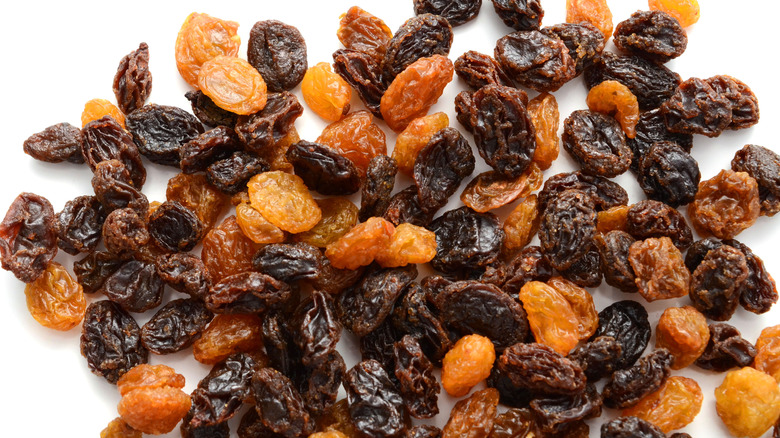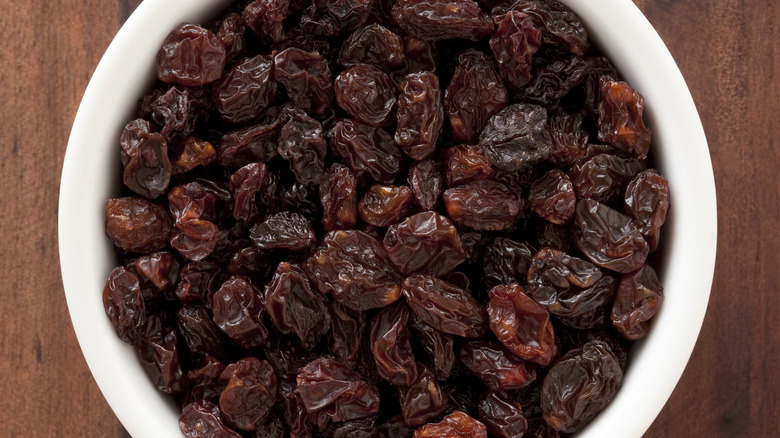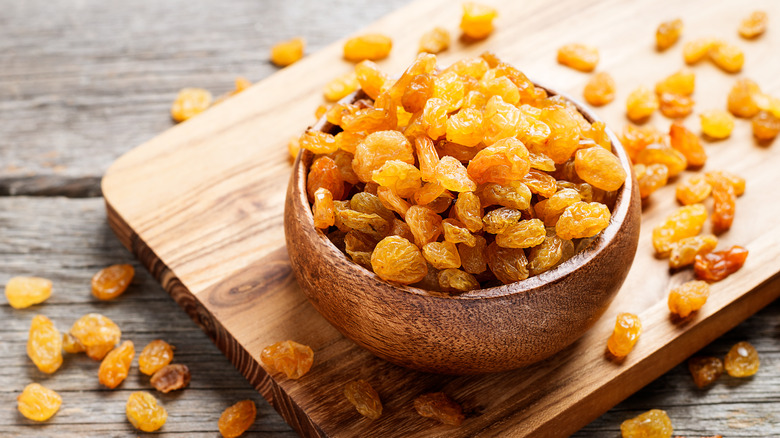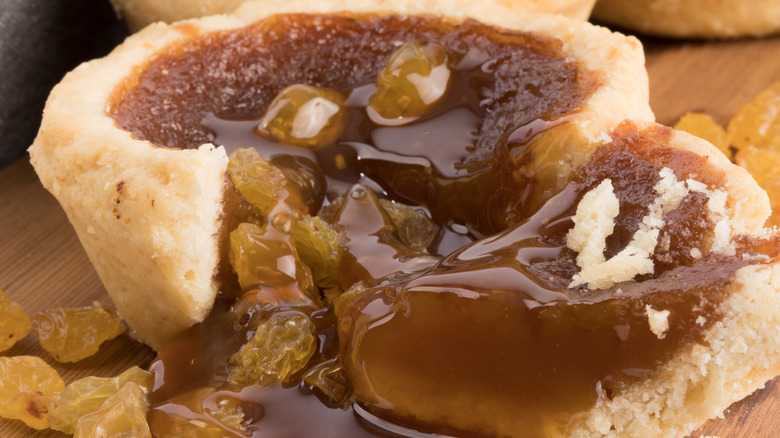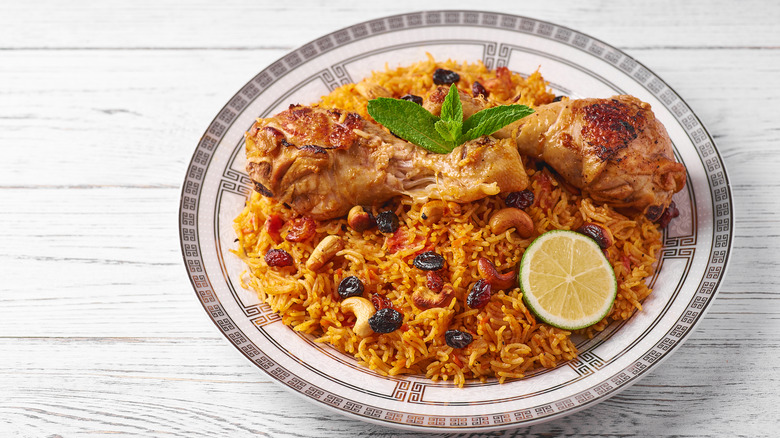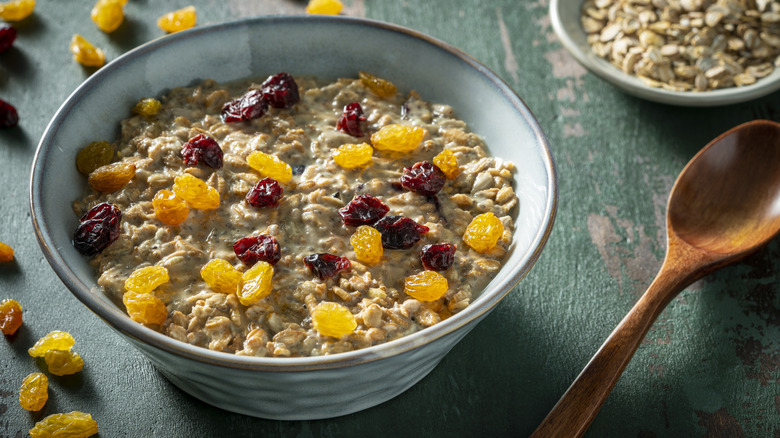Purple Vs Golden Raisins: What's The Difference?
Even though they're highly versatile food items that add fruity sweetness and texture to both savory dishes and desserts, raisins aren't everyone's favorite. And that's a shame because they're tasty, nutritious, affordable, and make for great snacks. You can even turn them into a gourmet ingredient by frying them in butter.
A common reason behind people's aversion to the dark purple-colored version of these dried fruits is how similar they look to chocolate chips when added to baked pastries — and how disappointing it is to taste anything other than the expected chocolate. However, what people might not be aware of is the variety of raisins available other than the unpopular purple ones. They can come in reddish brown, green, and gold, in a range of sizes and levels of sweetness.
Next to dark purple raisins, golden raisins are a widely available variant that's often used to substitute for the other in most recipes. In some cases, though, knowing their respective unique characteristics is helpful, especially when the type of raisin that must be used isn't specified. A little expansion of our knowledge can also increase our appreciation for them. After all, something this polarizing yet enduring must have some amazing qualities.
What are purple raisins?
When people mention raisins, they generally refer to the dried fruit that's dark purple — the one that tends to be mistaken as chocolate chips. In the U.S., they're typically made by dehydrating Thompson Seedless grapes under the sun. The fruits are left to dry in trays for two to four weeks until they lose as much as 85% of their water content. As the book On Food and Cooking explains, solar heat also causes the browning reaction between the sugars and amino acids present in the grapes and the phenolic compounds' browning-enzyme oxidation. These reactions lead to the raisins' dark color and caramelized flavor. Depending on the heat and their level of exposure to sunlight, they can turn even darker than purple and have a more intense flavor.
While sun drying is a time-tested and inexpensive way of dehydrating grapes, most manufacturers have come to rely on mechanical drying for a quicker process and improved quantity and quality of their yield. After all, it's more difficult to control the raisins' resulting color and aroma with sun drying, especially whenever the weather changes. It also leaves the fruits exposed to dust and insects.
What are golden raisins?
Golden raisins are made from a light-green variety of Thompson Seedless grapes, also known as Sultana grapes outside of the U.S. That's why another name for this variant is sultanas.
To produce different-colored raisins despite using the same type of grapes, manufacturers would treat the fruits with the antioxidant sulfur dioxide first, which functions as a preservative for both the grapes' flavor and color. They're then placed inside dehydrators. By using this mechanized process, manufacturers can control the level of temperature and humidity that the grapes are exposed to as they dry. This helps the golden raisins retain more of their plumpness and juiciness than the sun-dried purple ones. It's also a quicker drying process, taking only 24 hours. The drawback, however, is that it consumes more energy and is thus more expensive.
A word of caution, though: People with chronic asthma may have some sensitivity to the sulfur dioxide used to treat the grapes, according to a study published in the medical journal Critical Reviews in Toxicology. If you're allergic to sulfites, check the label for this ingredient before purchasing. Look for golden raisins that are marketed as "natural sultanas" and whose color leans more toward brown; these mean that they were produced without the sulfur dioxide treatment.
Golden raisins taste fruitier and are juicier than purple ones
Raisins' divisive reputation means that while some loathe them, there are also people who love them. One of whom is Ina Garten who likes to use golden raisins when baking. She explained in a "Barefoot Contessa" episode that she finds this variety to be "a little sweeter" than regular purple raisins. It also helped that their sunny color complemented the apple spice cake she was making.
While purple raisins are sweet as well, golden ones have a more nuanced flavor to them. Due to their controlled exposure to heat and humidity, they don't go through the level of caramelization that darker raisins do. Thus, they retain some of the grapes' natural tartness. In addition to the sulfur dioxide treatment, golden raisins also get coated with a vegetable oil solution before going through dehydration. This helps them retain some of their moisture, which makes them ideal for baking.
This isn't to say that you can't use purple raisins when baking pastries. Their more intense sweetness and pops of color work better for certain baked goods, such as cinnamon raisin bread. Just remember to soak them first in either water, liquor, or fruit juice for 30 minutes to plump them up and add another layer of flavor. Drain and dry the raisins afterward and coat them in flour before adding them to the batter. Doing these steps will keep the dried fruits from drawing moisture away from the pastry.
Purple raisins' more intense sweetness is great for savory dishes
Raisins of all types are high in sugar. They also have a chewiness to them that makes them a great addition to savory dishes that could use some depth and variety in their flavors and textures. In this arena, purple raisins might be the better choice. Their more concentrated sweetness can provide a perfect counterpoint to how salty and savory a dish is.
Purple raisins also do better when cooked compared to when they're baked. Adding them to stews or drizzling them with vinaigrette in salads will plump them right up, even when you chop them into smaller pieces. You can also incorporate them into flavorful sauces, such as the Italian classic agrodolce. It's a versatile dressing that can be used as a marinade, glaze, or spread because of its complementary combination of sour (agro) and sweet (dolce) flavors. A lot of chefs and home cooks have since expanded the agrodolce's ingredients to include more than the traditional vinegar, wine, and sugar. Dried fruits are now part of that list, too, so try making some at home using a handful of purple raisins. Golden raisins are okay, too, but for a more heightened zing of acidic sweetness in your sauce, the darker variant's caramelized flavor works perfectly.
Purple raisins contain more potassium
Due to the dehydration process they've gone through, both purple and golden raisins end up packed with nutrients. That's why adding them to your breakfast oatmeal or porridge is an easy way of making your first meal of the day more nourishing. On top of their nutritional and fiber content, all types of raisins — and dried fruits, in general — are rich in bioactive compounds that have antioxidant properties. Per a 2023 study published by the Multidisciplinary Digital Publishing Institute, these compounds have promising benefits to our gut health and also hold the potential for lowering cardiovascular risks, although further research still needs to be done.
Choosing which type of raisin to eat comes down to your taste. However, if you're looking for specific nutrients, purple raisins contain more potassium. They also contain iron, whereas golden raisins don't. At the end of the day, though, adding either one (or both) to your daily diet is good for your health.
